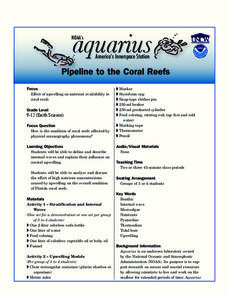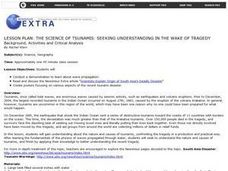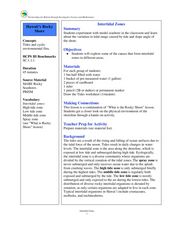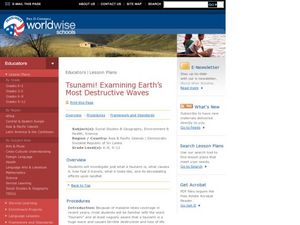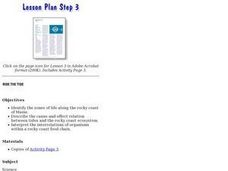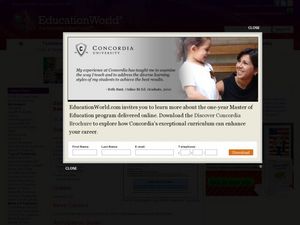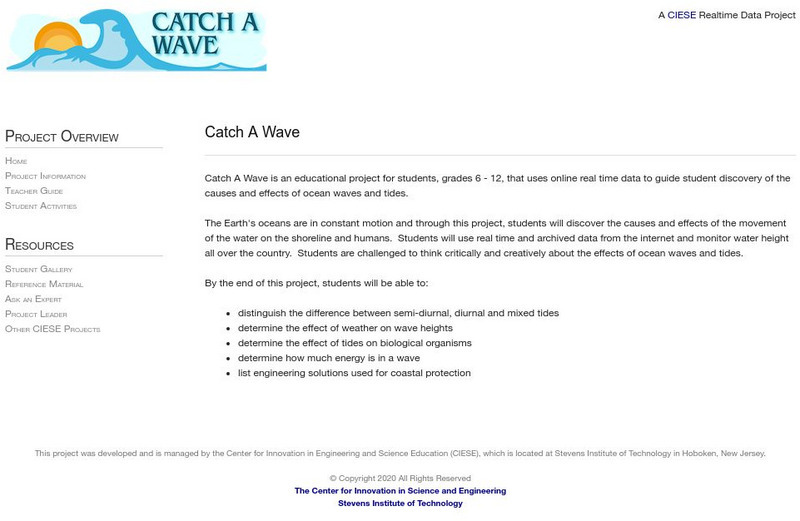Curated OER
Dynamic Earth
Students show how earthquakes affect sea waves. In this tidal waves instructional activity students use a rubber mallet on a table to create waves in a box on top of the table. They experiment with striking the mallet in different...
Curated OER
It Comes In Waves
Students investigate the behavior and different origins of tsunami waves, and they then research and chart the path of certain tsunamis from recent history using the Internet, maps and firsthand accounts.
Curated OER
Motion in the Ocean
How does the formation of currents and waves in the ocean happen? High schoolers will learn about the primary causes for ocean currents and waves by calculating a wave's amplitude and nautical mile speed. Then they will complete a...
Curated OER
Tsunami! Examining Earth's Most Destructive Waves
Learners investigate just what a tsunami is, what causes it, how fast it travels, what it looks like, and its devastating effects upon landfall. They read the experience of a former Peace Corps Volunteer who went to Sri Lanka after it...
Florida International University
Pipeline to the Coral Reefs
Discover firsthand the effects of internal waves on coral reefs. Through a series of experiments, learners simulate internal waves and upwelling events as they make observations on the movement of water and other debris. They then...
Curated OER
Long Day?
Students become aware of the effects of tides on the Earth's rotation. In this tides instructional activity, students calculate the number of seconds lost over various periods of time.
Curated OER
The Science of Tsunamis: Seeking Understanding in the Wake of Tragedy
Students use Internet research, articles, discussion and models to explore the dynamics of a tsunami. They focus on the 2004 Asian Tsunami and create posters illustrating their understanding of this phenomenon.
Curated OER
Tsunamis by the Book
Learners use the Internet and other sources to investigate tsunamis. They construct books listing several tsunami facts and cite their sources. They read their books to another class.
Curated OER
T3 Lesson Plan: Number 3
Sixth graders investigate local water. In this water cycle lesson, 6th graders take samples from surrounding water sources. Students record data from the samples, compare and graph the results.
Curated OER
Intertidal Zones
Students explore intertidal zones. In this intertidal zones lesson plan, students work in small groups and use ready-made materials to create a model of intertidal zones. Resources are provided.
Curated OER
Tsunami! Examining Earth's Most Destructive Waves.
Students discover what creates a tsunami In this earth science lesson, student research using the Internet how tsunami's develop. Students read accounts of first responders to the Sri Lanka tsunami.
Curated OER
Ride the Tide
Students examine the cause-and-effect relationship between tides and the rocky coast ecosystem. They complete a worksheet that illustrates the intertidal zone.
Curated OER
Time, Tide, and Quahogs
Students read tide tables for Waquoit Bay as the simulate determining the best time to go clam digging for a Wampanoag clambake. They graph the tide tables while realizing that the tides a Waquoit Bay are one hour later than those at...
Curated OER
Zoo Welcomes Baby Animals
Students engage in activities to gain a better understanding of endangered animals. In these animal lessons, students use vocabulary and comprehension skills to gain a better understanding of endangered animals. They also watch video...
Curated OER
Greek Myths
In this language arts worksheet, students discover 9 Greek gods, goddesses and heroes by reading paragraphs about them. Students then complete a crossword puzzle.
Curated OER
Salt Marsh in a Pan
Students create a model of a salt marsh to discover the impact of pollution and human activities on water-based habitats including bays and the ocean. They recognize the relationship between natural and developed areas. Students impact...
Curated OER
Pipeline to the Coral Reefs
High schoolers discuss the relationship of density to stratification. In this marine science lesson, students create a model of upwelling events using cold and warm water. They discuss how water phenomena affect coral reefs.
Center for Innovation in Engineering and Science Education, Stevens Institute of Technology
Ciese: Catch a Wave
In this project for Grades 6 to 12, students will use real data collected online to learn how waves and tides work. They will learn what causes water to move, and how waves and tides impact on humans, organisms and waterfront lands. They...
PBS
Pbs Teachers: Science of Tsunamis: Seeking Understanding in the Wake of Tragedy
Conduct a demonstration to learn about how waves function in water. Create a poster that shows the physics of waves, how tsunamis work, the devastation caused by the 2004 tsunami or information about relief efforts for the 2004 tsunami.




